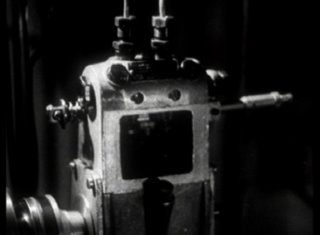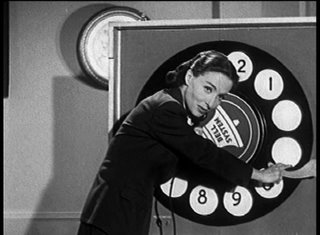
Reviews of film ephemera, including such things as educational films, industrial films, military and propaganda films, tv commercials, movie trailers, shorts, experimental films, and movies made for non-mainstream audiences.
Alice’s Mysterious Mystery (film #6 on Disc #1 of Disney Rarities DVD (Disney, 2005)). [Category: Hollywood]
This is the film that blew the lid off the whole “secret ingredient” in sausages conspiracy. Or, maybe not. Alice foils an evil cat who runs a dogmeat sausage factory, featuring a doggie death row where a dog priest prays over the hapless victims before they are turned into dogs of the hot variety. Dog lovers may find this a bit upsetting, though the evil cat gets his in the end. The beginning features some great cartoon vehicles.Ratings: Camp/Humor Value: ****. Weirdness: *****. Historical Interest: ****. Overall Rating: ****.
Biology (film #6 in the Schools section of TVArk). [Category: Educational]
Fairly cool opening credits for a British educational science program, featuring Pink Floyd’s “Time” as the music. I wonder if weird correlations could have been made had they replaced the entire program’s soundtrack with the rest of the album.Ratings: Camp/Humor Value: *. Weirdness: ***. Historical Interest: ****. Overall Rating: ***.
Annabelle Serpentine Dance #1 (film #5 on the Viva la Dance disc of Unseen Cinema DVD Boxed Set (Image Entertainment, 2005)). [Category: Early Film & TV]
Annabelle’s at it again, this time dancing in an incredibly twirly skirt, making her the idol of little girls everywhere. This one is beautifully hand-colored, making it fun to watch, though short. An 1894 Edison film.Ratings: Camp/Humor Value: *. Weirdness: ***. Historical Interest: *****. Overall Rating: ****.
Beast of Blood Trailer (extra on Beast of Blood DVD (Image Entertainment, 2002). Also, extra on Brain of Blood DVD (Image Entertainment, 2002. Also, extra on Brides of Blood DVD (Image Entertainment, 2002). Also, extra on Mad Doctor of Blood Island DVD (Image Entertainment, 2002)). [Category: Commercial]
Very campy trailer for an incredibly cheap 70s horror flick, featuring a guy in a rubber mask killing guys on a ship, a mad scientist doing hideous experiments with the deadly chemical chlorophyll (so that’s what happened to all those 50s folks who used chlorophyll toothpaste!), cardboard sets, disembodied screaming voices, lurid titles, and One Way to Get Ahead. This ranks with the best cheesy 50s horror films, except it’s in lurid color and a little bit bloodier. Loads of fun.Ratings: Camp/Humor Value: *****. Weirdness: *****. Historical Interest: *****. Overall Rating: *****.
The Arava Is My Home (film #11 in the Rural Settlement and Security section of the State of Israel section of Stephen Spielberg Jewish Film Archive). [Category: Sleaze & Outsider]
This early-70s Israeli film shows us what it was like to develop and live on a desert kibbutz. A man who lives on a kibbutz in the Arava desert area narrates the film, telling us about the hardships he and the early pioneers went through to build their desert home, including crop failure, flash floods, terrorist attacks, and the omnipresent heat. Eventually, though, they are successful in building a viable agricultural settlement, including homes with modern conveniences, such as running water and electricity. This is a valuable historical document of the development of the kibbutz way of life in Israel. It’s straightforwardly told, with few surprises, but the story is pretty interesting nonetheless.Ratings: Camp/Humor Value: *. Weirdness: **. Historical Interest: ****. Overall Rating: ***.
And Still They Come (film #8 in the Immigration and Absorption section of the State of Israel section of Stephen Spielberg Jewish Film Archive). [Category: Public Service]
This early-60s film documents the work of the Youth Allyah in Israel, a program that rehabilitated and resettled displaced and orphaned Jewish children and adolescents. Most of these young people had been traumatized; many came from chaotic backgrounds of homelessness or poverty. Rehabilitation through education, creative work, agricultural work, physical training, and vocational training is shown. This is a very hopeful and optimistic public service film, showing young people who have survived horrors being placed in a nurturing environment and allowed to grow. The story of artist and Holocaust survivor Yehuda Bakon frames the larger story, and we get a chance to see his compelling artwork that documents both the horrors he survived and his healing process. Unfortunately, the copy of the film in the Spielberg Archive is dark and hard to see. Still, this is a compelling film that is worth watching.Ratings: Camp/Humor Value: N/A. Weirdness: ***. Historical Interest: *****. Overall Rating: ****.
Abstract Movies (film #27 on the Light Rhythms disc of Unseen Cinema DVD Boxed Set (Image Entertainment, 2005)). [Category: Outtakes & Obscurities]
A collection of short experimental films made by abstract painter George Morris. These start out as simple pans and zooms of his paintings, but go on to fairly mesmerizing experiments in stop-motion animation, cut-paper puppetry, and bizarre shots of body parts. I particularly like the framed heads and the sparkly hand that makes stars. A visually interesting film collage.Ratings: Camp/Humor Value: **. Weirdness: ****. Historical Interest: ****. Overall Rating: ****.
Fiesta Soundie (film #509 on Prelinger Archive). [Category: Hollywood]
This peppy soundie has Mexican stereotypes aplenty, as well as hot Latin rhythms. It tells the musical story of the love of a codependent wife for her worthless husband Pancho. It's all rather silly, but it's got rhythm.Ratings: Camp/Humor Value: ***. Weirdness: ***. Historical Interest: ***. Overall Rating: ***.

Cosmonaut: Russian Orbits Globe 17 Times (film #135 on Universal Newsreels).[Category: News]
Early 60s newsreel story about a Russian cosmonaut’s circling of the earth, back when the Russians were kicking our butts in the space program. There’s some campy scenes of distressed-looking Americans peering at lurid newspaper headlines about the spaceflight. Then, because the Russians kept everything top secret, we get to see stock footage of what the flight might have, but probably didn’t, look like, culminating in a plastic globe spinning around with a satellite connected to a wire to represent the spacecraft. They might as well have mined the Universal vaults for the old logo with the biplane. Pretty silly for what was supposed to be a straight newsreel.Ratings: Camp/Humor Value: ****. Weirdness: ***. Historical Interest: ****. Overall Rating: ****.
As Always, Hadassah (film #2 in the Health section of the State of Israel section of Stephen Spielberg Jewish Film Archive). [Category: Military & Propaganda]
This early-70s film documents the efforts of the medical staff and volunteers of the Hadassah Mt. Scopus hospital in Jerusalem to treat and rehabilitate wounded soldiers and civilians of the Yom Kippur War. It’s a fairly compelling story, but the stark, early-70s style of the film tends to make it drag a bit. Still, you get a real sense for the medical practices of that time and place, as well as what it was like to try to provide medical treatment in wartime conditions.Ratings: Camp/Humor Value: *. Weirdness: **. Historical Interest: ****. Overall Rating: ***.

Dial Comes to Town (film #433 on Prelinger Archive). [Category: Industrial]
If you’re watching ephemeral films in order to laugh at dorky innocent people from the past, then this is your film. Gramps is all up in arms because there’s talk that they’re gonna install them there phones with dials on ‘em! Fortunately, the rest of the family is a little more on the early adapter side, so they take him to a long meeting about dial phones, where they explain way more than you want to know about how they installed them. Then you get to the meat of the film, where a pretty lady laboriously shows us how to make a call on a dial phone, using enough repetition that even the lower-1Q folks like Gramps get it. She uses a huge telephone dial as a visual aid, which definitely has my name on it for the Film Ephemera Museum of Quirky Devices (I called it first!). This is a highly entertaining film, with a great opening featuring a stop-motion animated dial that installs itself on a telephone. This is definitely one to have in your collection.Ratings: Camp/Humor Value: *****. Weirdness: ****. Historical Interest: *****. Overall Rating: *****.
Choosing for Happiness (in the Ephemeral section of Open Video Project. Also, film #318 on Prelinger Archive). [Category: Educational]
College girl Mary narrates this film about her friend Eve, and why, despite Eve’s good looks, she hasn’t found a husband yet. It turns out that Eve is as controlling as all get out, throwing a snit fit whenever a boyfriend fails to do exactly as she orders. The message here is that you can’t change other people, you can only change yourself. It’s a sound message, as far as that goes, except that you don’t get the feeling that young men during the 50s were getting the same message from social guidance films. When you take into consideration the blatant sexism of the 50s, it’s disturbing to hear young women being encouraged to “take men as they come”––it seems to be more about subservience than about healthy relating, despite the fact that Eve’s controlling behavior is genuinely annoying, and the boyfriends are portrayed as decent sorts mostly. And the film is made in an annoyingly confusing style, with Mary narrating Eve’s story, when Eve really should be doing it herself. There are also bits of wacked-out dialogue that make you wonder what the writers could have been thinking, especially the scene with Eve and supernerd boyfriend Arthur the Math Major. This makes the film more confusing than it needs to be, and it makes me wonder how it went over with its intended audience.Ratings: Camp/Humor Value: ****. Weirdness: ****. Historical Interest: *****. Overall Rating: ****.
Alice’s Egg Plant (film #4 on Disc #1 of Disney Rarities DVD (Disney, 2005)). [Category: Hollywood]
Alice runs a poultry farm in this cartoon, and she learns that the solution to labor-management problems is to hold a cockfight. I’m serious. This gets awfully close to being capitalist propaganda, except all the eggs are lost in the end. Phew!Ratings: Camp/Humor Value: ***. Weirdness: ****. Historical Interest: ****. Overall Rating: ****.
A Day in the Life of a Coalminer (track #8 on The Movies Begin, Volume Three: Experimentation and Discovery (Kino Video, 1994)). [Category: Early Film & TV]
This fascinating film is probably one of the first documentaries ever made, showing us the real work of real turn-of-the-century coalminers. There are many unforgetable images here of men being squeezed like sardines into tiny elevators, men working in dark, cavelike corridors hundreds of feet underneath the ground and looking like they never get a chance to stand upright all day, men getting paid a small handful of coins for their labors. But what's really striking is the women. Yes, there are dozens of women in this mine doing such "women's work" as loading huge logs onto handcarts, hunching over a conveyor belt sorting coal, and standing on top of coal hoppers poking the coal with pitchforks. The classist ending will disgust you, or you have a heart of stone, I'll warrant. A fascinating historical document of hard, dirty labor. A 1910 Kinetescope film.Ratings: Camp/Humor Value: N/A. Weirdness: ***. Historical Interest: *****. Overall Rating: *****.
Subscribe to:
Comments (Atom)
Better Reading
Better Reading . Teenager Harold Wilson has a problem—he can’t read for (expletive deleted). So he has to spend all his free time studying ...

-
The Best Made Plans. A 50s housewife solves all problems with Saran Wrap plastic film. Of course, all her problems are the kinds we all wa...
-
Better Reading . Teenager Harold Wilson has a problem—he can’t read for (expletive deleted). So he has to spend all his free time studying ...
-
Annie Oakley – Annie and the First Phone (film #15 in the Classic TV section of Movieflix ). [Category: Early Film & TV] This early-50s ...